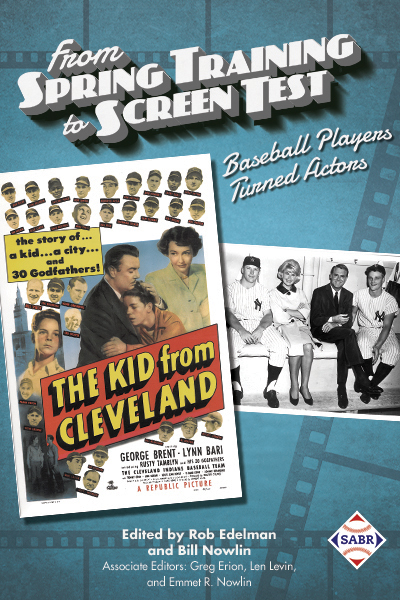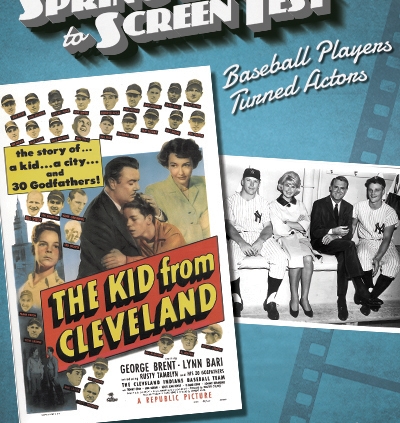Introduction: From Spring Training to Screen Test
This article was written by Rob Edelman
This article was published in From Spring Training to Screen Test: Baseball Players Turned Actors
Why would you want to squander a few hours taking up space in your behind-home-plate seat at a World Series game? For after all, you’ve been invited to a screening of a spanking new 35 mm print of Bela Lugosi Meets a Brooklyn Gorilla.
Why bother wasting time watching Bull Durham, Field of Dreams, Bang the Drum Slowly – or Joe E. Brown cavorting in Fireman, Save My Child, Elmer the Great, and Alibi Ike? Instead, you could turn on the tube and take in a baseball game – ANY baseball game, even one between two second-division nines in the dog days of August.
 Granted, these queries are exaggerations. But they only are slight ones. In truth, some baseball fan-atics see no purpose in savoring motion pictures with ballyard settings or references. Their argument is that baseball-on-screen has nothing whatsoever to do with real baseball. These detractors will emphasize only the factual errors in the screenplay, as if all baseball films are scripted by writers who neither understand nor care about the game. This simply is not so.
Granted, these queries are exaggerations. But they only are slight ones. In truth, some baseball fan-atics see no purpose in savoring motion pictures with ballyard settings or references. Their argument is that baseball-on-screen has nothing whatsoever to do with real baseball. These detractors will emphasize only the factual errors in the screenplay, as if all baseball films are scripted by writers who neither understand nor care about the game. This simply is not so.
Conversely, some movie buffs become panic-stricken at the thought of appreciating sports in general, and baseball in particular. They contend that baseball is boring, is sleep-inducing. A film like Bela Lugosi Meets a Brooklyn Gorilla is far more intoxicating. But if you’ve ever stumbled upon a screening of Bela Lugosi Meets a Brooklyn Gorilla, you will see that this too simply is not so.
The book that you are about to peruse brings together these two separate yet inexorably connected domains: the sport of baseball and the art and creativity of film, television, and other forms of entertainment. Undeniably, for well over a century, acting onscreen and swatting horsehides have been interwoven – and innumerable real-life ballplayers have appeared in the movies, on Broadway, in vaudeville, and, eventually, on television.
Some baseball folk have had extensive careers in the performing arts. Such a list begins with Mike Donlin, Chuck Connors, Bob Uecker, Edgar “Blue” Washington, Jim Thorpe, Pat Flaherty, Greg Goossen, Art Passarella, John Beradino (whose surname while he played baseball was Berardino), and Bernie Williams. Show biz-luminaries who never played in the majors – they include Gene Autry, Ron Shelton, Thomas Tull, DeWolf Hopper, Digby Bell, Joe E. Brown, Buster Keaton, and Happy Felton – are among the celebs with major baseball connections. In the research for Meet the Mertzes, a double biography of I Love Lucy’s Vivian Vance and super-baseball-fan William Frawley, more of Frawley’s baseball buddies were tracked down and interviewed than his Hollywood colleagues. In 2014, in a brief chat with Bill Murray at the Toronto International Film Festival, I queried this ardent Chicago Cubs aficionado as to when his team would cop the World Series. His ever-so-optimistic response was: two years. Wouldn’t you know that Mr. Murray was spot-on in his prediction!
Other big-name players or managers occasionally have appeared onscreen, often as themselves, in starring or featured roles – or, in some cases, a single starring or featured role. Among them are John McGraw, Jackie Robinson, Lou Gehrig, Ty Cobb, and Babe Ruth. In particular, The Bambino’s larger-than-life, overgrown teddy-bear personality registers well onscreen. If he had not been a ballplayer, he might have made an effective sidekick or foil for any number of screen comedians. One can imagine The Three Stooges being rechristened The Four Stooges, with Moe, Larry, and Curly being joined by The Babe as they gleefully hurl pies at one another, tweak each other’s noses, and knock each other with mallets.
Occasionally, an unlikely personage even pops up onscreen and references the sport. Back in 2016, My X-Girlfriend’s Wedding Reception, an obscure low-budget comedy from 1999, became a hot ticket. The reason: In its cast is none other than Bernie Sanders, presidential contender. He is billed as “Congressman Bernie Sanders,” and he plays a rabbi by the name of “Manny Shevitz.” (Now remember, this is a comedy.) At one point, Rabbi Manny is addressing the wedding guests. He begins by observing: “Today we celebrate life, a very sacred part of life.” That’s fair enough coming from a religious leader, but then Rabbi Manny, after declaring that he, like the man who plays him, was born and raised in Brooklyn, immediately goes on a riff about the tragedy of the Dodgers leaving the Borough of Churches. Then, as if he is addressing a convention of sports fans rather than a wedding party, he segues into a criticism of baseball free agency.
Clusters of big-league nines also have been featured in movies: the Cleveland Indians in The Kid From Cleveland (1949); the Los Angeles Dodgers in The Geisha Boy (1958); the New York Yankees in Safe at Home! (1962); the Dodgers and San Francisco Giants in Experiment in Terror (1962). Countless hitters and hurlers from Joe DiMaggio and Satchel Paige to the two Wallys – Hebert and Hood – have made token cameo appearances. Consequently, for researching this book and selecting its content, make no mistake: If we had set out to offer bios of every ballplayer who ever made even a single appearance in a single motion picture, the result would be a mini-encyclopedia. The purpose here is to offer a general survey of the connection between baseball and entertainment along with a range of select topics, from baseball on television shows and in Coca-Cola commercials to Jim Bouton’s Ball Four TV series.
Anecdotes connecting ballplayers and movies are endless. Back in 2011, a piece on The Jackie Robinson Story (1950) and how it is a reflection of its era was published in NINE: A Journal of Baseball History and Culture.1 While preparing the article, I scrutinized its credits on the Internet Movie Database and there, on this particular cast list, was a familiar name: Dick Williams, who is listed as “Jersey City Pitcher/Second Baseman (uncredited).” Was this the Dick Williams, who now is a Baseball Hall of Famer? Perhaps it might be because Williams started out in the Brooklyn Dodgers organization, which was involved in the film’s production. Plus, upon a replay of The Jackie Robinson Story on DVD, that “uncredited” actor certainly resembled a young Dick Williams. But where was the proof? How did Williams become connected to the film? Well, it just so happened that the Hall of Fame Classic was momentarily being played in Cooperstown. Dick Williams was in attendance, and he was cornered and asked about the film. Even though The Jackie Robinson Story had been made over six decades earlier, Williams recalled it vividly and was quoted in the piece.
Additionally, beyond Williams’s participation in The Jackie Robinson Story, and beyond the entertainment quotient in this or any film, motion pictures serve as reflections of history and the culture from which they emerged. And The Jackie Robinson Story is not the lone film that connects baseball and mid-twentieth-century America. Far from it. One of innumerable examples: Attitudes relating to US involvement in World War II at different moments in time are mirrored in the baseball sequences in Woman of the Year (1942), The Best Years of Our Lives (1946), and Three Stripes in the Sun (1955). Films can also serve as valuable educational tools: A League of Their Own (1992) almost singlehandedly revived interest in the long-extinct All-American Girls Professional Baseball League.
However, the essence of this book is the link between the real and the reel. And most tellingly, real-world baseball personalities occasionally offer knowing winks to savvy viewers. In Big Leaguer (1953), Carl Hubbell (playing “Carl Hubbell”) arrives in spring training to evaluate New York Giants prospects. In the climactic game, with the Giants behind 7-4 in the ninth inning, King Carl perceptively notes: “The game’s now getting interesting.” In Three Stripes in the Sun, Chuck Connors appears as a GI stationed in postwar Japan who pitches in a game between the Americans and Japanese. Before the contest, as per custom, the Japanese players remove their caps and bow; they are followed by the umpires, and then the Americans. After the ritual, Connors’s character comments: “What would Durocher say if he saw this?”
Some are intentionally funny: In a 1985 TV version of Casey at the Bat, Joe (Bob Uecker, he of the lifetime .200 batting average), an announcer, asks Casey (Elliott Gould) what it feels like to hit a baseball. Ernie (Howard Cosell), a fellow broadcaster, quips: “That’s something Joe never experienced in his life.” Others are unintentionally sad and ironic: In Rawhide, a 1938 sagebrush saga, Lou Gehrig stars as himself; at the outset, he catches a train at Grand Central Station and tells reporters: “I’m gonna wallow in peace and quiet for the rest of my life. I’m gonna hang up my spikes for a swell old pair of carpet slippers.”
If you take pleasure in everything from privileged peeks at the post-World War II Cleveland Indians and newly-minted Los Angeles Dodgers to Don Drysdale cast as “Don Drysdale” on TV’s The Donna Reed Show, Leave It to Beaver, and The Brady Bunch, you surely will savor watching and relishing baseball on the big and small screens. And you certainly will find much to enjoy, and much to discover, as you pore over this book.
ROB EDELMAN is the author of Great Baseball Films and Baseball on the Web (which Amazon.com cited as a Top 10 Internet book), and is a frequent contributor to Base Ball: A Journal of the Early Game. He offers film commentary on WAMC Northeast Public Radio and is a longtime Contributing Editor of Leonard Maltin’s Movie Guide and other Maltin publications. With his wife, Audrey Kupferberg, he has coauthored Meet the Mertzes, a double biography of Vivian Vance and super-baseball fan William Frawley, and Matthau: A Life. His byline has appeared in Total Baseball, The Total Baseball Catalog, Baseball and American Culture: Across the Diamond, NINE: A Journal of Baseball History and Culture, The National Pastime: A Review of Baseball History, The Baseball Research Journal, and histories of the 1918 Boston Red Sox, 1947 Brooklyn Dodgers, 1947 New York Yankees, and 1960 Pittsburgh Pirates. He is the author of a baseball film essay for the Kino International DVD Reel Baseball: Baseball Films from the Silent Era, 1899- 1926; is an interviewee on several documentaries on the director’s cut DVD of The Natural; was the keynote speaker at the 23rd Annual NINE Spring Training Conference; and teaches film history courses at the University at Albany (SUNY).
- Read more: Find all essays in From Spring Training to Screen Test in the SABR Research Collection online
- SABR BioProject: Find all biographies of players featured in From Spring Training to Screen Test
- E-book: Click here to download the e-book version of From Spring Training to Screen Test for FREE from the SABR Store. Available in PDF, Kindle/MOBI and EPUB formats.
- Paperback: Get a 50% discount on From Spring Training to Screen Test paperback edition from the SABR Store ($17.99 includes shipping/tax; delivery can take up to 3-4 weeks.)
Notes


